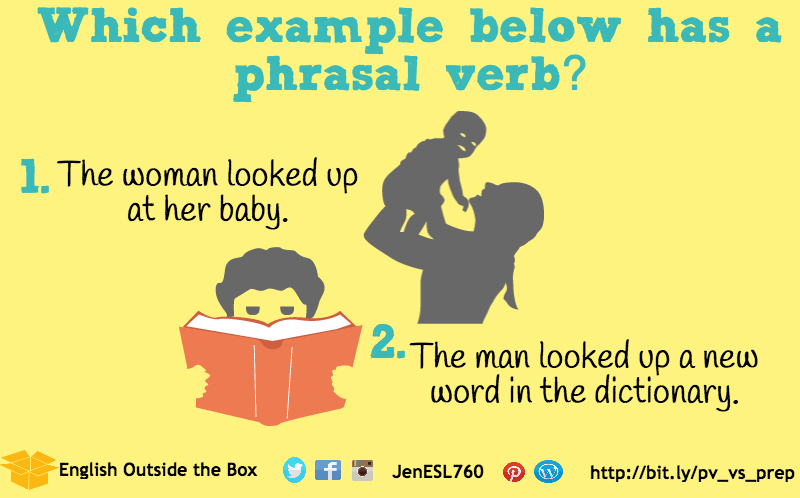
Phrasal Verb Friday | Phrasal Verbs VS Verb + Prepositions
The past few Fridays have been spent reviewing a variety of phrasal verbs and how to learn them, but what exactly is a phrasal verb? What is the difference between phrasal verbs and verb + preposition combinations? Yes, did you know that second or sometimes third part of a phrasal verb is actually not a preposition? Where do the objects go? Do all phrasal verbs even have objects?
If any of these questions left you scratching your head (confused), then have no fear! You are about to find out everything you need to know when learning phrasal verbs.
First things first, what exactly is a phrasal verb?
A phrasal verb is an idiomatic phrase, a group of words that “acts” (functions) like a verb. These must be learned as a singular unit, like vocabulary, because of its structure:
main verb + particle
How do phrasal verbs differ from verb + preposition combinations?
This particle in the structure, although looks like a preposition (or adverb), is not. When combined with the main verb, it changes the meaning of the verb to create a unique expression. When looked at as 2 (or 3) individual words, it makes absolutely no sense.
Let’s look at the example “look up”.
-“up” appears to be a preposition/adverb, and it is! If we use “up” as one of these parts of speech, and combine it with the verb “look,” the word is simply telling us WHERE to look. We can look down (towards the ground), up (towards the sky), right, left, etc. You can see how the word “up” does not change the meaning of the verb “look,” it just adds details.
-“up” when used as a particle with “look,” forms the phrasal verb “look up” which has a definition: finding information in a book (or online)
So we can see that in this case, “up” changes the meaning of the main verb, and it forms an entirely new definition.
Let’s examine another example, this time using a 3-word phrasal verb, and a 3 word verb + preposition [both] in one sentence example.
“I have a new idea that I came up with, so come up the stairs with Paulo and I’ll tell you both about it.”
Is the first example a phrasal verb or verb + preposition combo? How do you know?
Answer:
It’s a phrasal verb, and you can determine that be taking apart the words of the phrase. Do they make sense individually? No, “come up with” means “to think of something, usually that is needed/wanted” In this case, it’s referring to an idea that I thought of, that I have. Taking the phrase apart would make no sense.
It would make sense though, if we did it for the second example…
-What is the action? come
-Come where? up
-Come up alone? No, with Paulo
Is it starting to make sense?
Why is this important to know?
Well, let’s imagine you are reading, watching TV, or listening to some spoken English somewhere. You hear this combination of words that you don’t understand. You hear it, you understand what the words are, but you can’t quite understand the meaning of everything combined into a particular sentence. What do you do? Do you learn the words individually? Do you learn them together? AHH! SO MANY CHOICES. If you understand how to break the phrases apart into individual words, and if you can quickly determine if the second/third word is only 1) providing details (preposition/adverb) or 2) changing the meaning (particle) you’ll know how to move forward discovering the meaning.
Where do the objects go [in a phrasal verb]? Do all phrasal verbs even have objects?
This answer is going to depend on 3 things:
-1) Is the phrasal verb transitive or intransitive?-2) Is the phrasal verb separable or inseparable?-3) Is the object a noun or a pronoun?
1) If the phrasal verb is transitive, then it takes an object. If it is intransitive, then it does not take an object. Examples?
-call off: to cancel something
Rebecca called off the party last minute because of the terrible weather.
This example shows a transitive verb, so it takes an object. Rebecca, the subject, called off [or cancelled] something, the object, which was “the party.” Do you notice where the object is placed?
-drop in: to go somewhere unexpectedly for a short time
My parents dropped in on their way to California.
This phrasal verb is intransitive, so it doesn’t take an object because the subject is the one “doing” the phrasal verb. In this case, don’t worry about where to put the object because it doesn’t exist!
2) If the verb is separable, then you can separate the main verb and its particle. This means that putting the object between the two is possible. On the other hand, as you can probably guess, you cannot separate an inseparable phrasal verb, so the object must go after the final particle. *Note: I said it is possible to put an object in between a verb and the particle if its separable, but not necessary. The most important rule of thumb is this: if the object is long, put it after; otherwise, both will be okay.
*call off- separable *call off the party *call the party off*look after-inseparable *look after the baby
3) Finally, if the object is a pronoun, it must go in between the verb and particle, assuming it is separable. Follow the same rule as above for inseparable phrasal verbs, don’t separate! Objects that are noun can go in between or after, see #2 above.
*call it off (it, referring to ‘party’) *look after her.
Remember the last post, Reading Comprehension with Bree-Elizabeth Part 1? I hinted that we would be using that text to analyze phrasal verbs this week, so I will be using that post as a way to practice and follow up with this information here.
What do you need to do? How will you practice?
Click the link above to get right over to Bree-Elizabeth’s story, and start reading the text. I want you to find all of the phrasal verbs/verb + preposition combinations, and then identify which category they fall into: phrasal verb? or verb + preposition? This will also be a great way to learn over 30 (potentially) new phrasal verbs! WAHOO! Double Score! Keep this information close and handy (easily accessible), because I will be posting the list of answers in a couple of days! If you’re reading this post later, be sure to refer to the next post to find the answer list!
Still feeling confused? Need more information about phrasal verbs?
Consider taking a grammar class with me, Jennifer! You can sign up (phrasal verb!!!= register) for the entire course, or just 1 or 2 lessons focusing primarily on phrasal verbs, it is up to you! Having a follow up class would be a great way to review this information, get the answers to more questions, and get even more practice with speaking. If you are interested visit English Outside the Box, or just click here.

[…] speaker, who is not a teacher, what an adjective clause is? Perhaps the structure of a phrasal verb (and the difference between a particle and preposition)? Or why we use the simple past in the if clause of the present/future unreal conditional? Chances […]
I would like to hear about tools fot teaching.i have 120 hour tefl certificate
Reblogged this on So, You Think You Can Teach ESL?.
Very well explained!